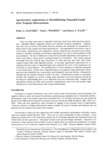Agroforestry Approaches or Rehabilitating Degraded Lands after Tropical Deforestation
JIRCAS international symposium series
| ISSN | 13406108 |
|---|---|
| 書誌レコードID(総合目録DB) | AA1100908X |

本文フルテキスト
intlsymp-1_108-119.pdf542.86 KB
There are three main types of degraded lands that result from slash and burn agriculture : degraded fallows, degraded pastures and Imperata cylindrica grasslands. Together they may cover as much as 250 million hectares, and have the advantage for recuperation of being close to road, market and urban infrastructure. Land degradation can be due to one or more causes: physical (e.g. soil compaction, erosion), chemical (e.g. increases in soil acidity, decline in available nutrients) and biological degradation (e.g. loss of microsymbionts, weed encroachment). The use of bulldozers to clear land accelerates degradation and generally requires more labour, energy and/or purchased inputs for reclamation. The current research knowledge base has focused upon alternatives to slash and burn that start with fertile, cleared forests rather than degraded systems. In the past, agroforestry approaches for reclaimimg the three types of degraded lands were employed but most of the experiences are not based on sound research. The establishment of Acacia mangium on Imperata grasslands is one success story. In the case of degraded fallows and pastures, land regeneration strategies have been identified (e.g. economically and biologically improved fallows; silvopastoral systems) but the essential research is still to be done. Fundamental concepts of restoration ecology with emphasis on nutrient cycling, plant succession and weed dynamics should set the stage for understanding how to turn degraded areas into productive lands. Coupled with appropriate policies and other socio-economic considerations, such work will provide viable alternatives to land abandonment after tropical deforestation.
| 作成者 | Pedro A. SANCHEZ Paul L. WOOMER Cheryl A. PALM |
|---|---|
| 公開者 | Japan International Research Center for Agricultural Sciences |
| オンライン掲載日 | |
| 号 | 1 |
| 開始ページ | 108 |
| 終了ページ | 119 |
| 言語 | eng |
